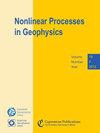三维涡流中微浮力微塑料的聚集
IF 2.4
4区 地球科学
Q3 GEOSCIENCES, MULTIDISCIPLINARY
引用次数: 0
摘要
摘要尽管对微塑料在海洋表面的运动和聚集进行了深入研究,但对其在海洋表层下的运动和聚集却知之甚少。在管理具有高阻力的小硬质球体在流体中运动的 Maxey-Riley 框架中,浮力颗粒的聚集在涡流主导的区域受到鼓励。我们在一个理想化模型中探讨了这一过程,该模型在性质上与具有方位角和翻转环流的三维漩涡相似。在轴对称状态下,没有在顶部边界聚集的浮力球形粒子会被吸引到由周期性轨道组成的环路中。当粒子受到的阻力足够大时,就会出现这种环流。对于小的、稍有浮力的粒子来说,这种环路位于周期性流体包裹轨迹附近。如果对称流受到对称性破坏扰动的扰动,在扰动产生的共振区内的流体包裹周期性轨道附近,可能会出现小的、刚性的、轻微浮力粒子的额外吸引子。具有周期性或准周期性时间依赖性的扰动可能会产生更多的吸引子,其形状和位置会周期性地重复出现。然而,并非所有此类环路都会产生吸引,在一个环路附近释放的刚性粒子可能会被吸引到附近的吸引子上。本文列举了一些例子,并给出了各自吸引盆地的映射。本文章由计算机程序翻译,如有差异,请以英文原文为准。
Aggregation of slightly buoyant microplastics in 3D vortex flows
Abstract. Although the movement and aggregation of microplastics at the ocean surface have been well studied, less is known about the subsurface. Within the Maxey–Riley framework governing the movement of small, rigid spheres with high drag in fluid, the aggregation of buoyant particles is encouraged in vorticity-dominated regions. We explore this process in an idealized model that is qualitatively reminiscent of a 3D eddy with an azimuthal and overturning circulation. In the axially symmetric state, buoyant spherical particles that do not accumulate at the top boundary are attracted to a loop consisting of periodic orbits. Such a loop exists when drag on the particle is sufficiently strong. For small, slightly buoyant particles, this loop is located close to the periodic fluid parcel trajectory. If the symmetric flow is perturbed by a symmetry-breaking disturbance, additional attractors for small, rigid, slightly buoyant particles may arise near periodic orbits of fluid parcels within the resonance zones created by the disturbance. Disturbances with periodic or quasiperiodic time dependence may produce even more attractors, with a shape and location that recurs periodically. However, not all such loops attract, and rigid particles released in the vicinity of one loop may instead be attracted to a nearby attractor. Examples are presented along with mappings of the respective basins of attraction.
求助全文
通过发布文献求助,成功后即可免费获取论文全文。
去求助
来源期刊

Nonlinear Processes in Geophysics
地学-地球化学与地球物理
CiteScore
4.00
自引率
0.00%
发文量
21
审稿时长
6-12 weeks
期刊介绍:
Nonlinear Processes in Geophysics (NPG) is an international, inter-/trans-disciplinary, non-profit journal devoted to breaking the deadlocks often faced by standard approaches in Earth and space sciences. It therefore solicits disruptive and innovative concepts and methodologies, as well as original applications of these to address the ubiquitous complexity in geoscience systems, and in interacting social and biological systems. Such systems are nonlinear, with responses strongly non-proportional to perturbations, and show an associated extreme variability across scales.
 求助内容:
求助内容: 应助结果提醒方式:
应助结果提醒方式:


